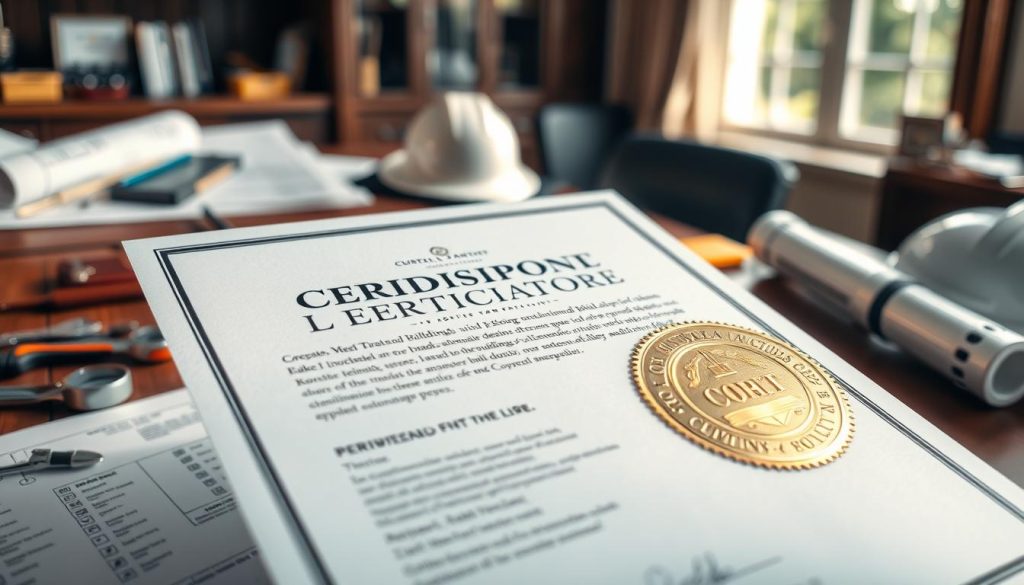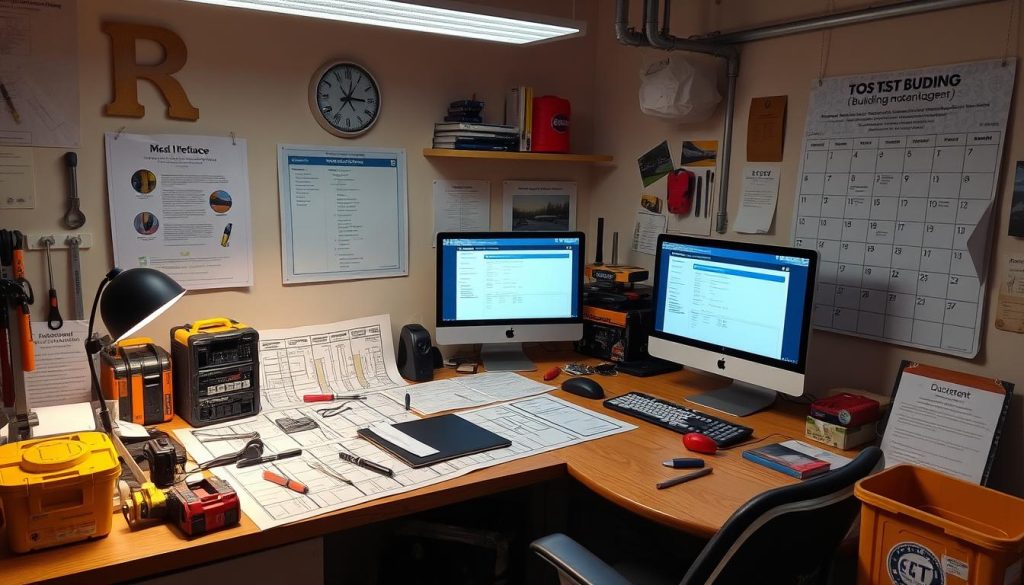CBMM (Certified Building Maintenance Manager) Test Guide
Getting the Certified Building Maintenance Manager (CBMM) certification can really boost your career. This guide gives you all the info and tips you need to pass the CBMM test. It’s perfect for both experienced professionals and newcomers to building maintenance.
Learn why building maintenance certification matters, what the CBMM credential offers, and how to do well on the test. This guide will help you reach your full potential in facility management and building operations.

Key Takeaways
- Understand the significance of the CBMM certification in the facility management industry
- Explore the scope and benefits of the CBMM credential for your career
- Discover effective strategies and best practices to excel in the CBMM test
- Gain insights into the key areas of building systems and maintenance practices
- Leverage the CBMM certification to advance your career in building operations
Unlock Your Career in Building Maintenance: Understanding the CBMM Certification
Getting a building maintenance certification like the CBMM is key in the facility and commercial real estate worlds. It shows you know how to manage building systems and follow codes and regulations. It also means you’re good at making buildings energy-efficient and sustainable. Getting this certification can open up new job chances, make you more respected in your field, and show you’re a big help to your employer.
The Importance of Building Maintenance Certification
The CBMM (Certified Building Maintenance Manager) credential checks if you really know your stuff in building maintenance. It covers things like HVAC, electrical, plumbing, and building codes. It also looks at preventive maintenance and how to make buildings better for the environment. Getting this certification can lead to more job chances, better pay, and more respect in your field.
Exploring the CBMM Credential: Scope and Benefits
The CBMM (Certified Building Maintenance Manager) certification is a big deal. It teaches you everything you need to know to be great at building maintenance. It shows you’re good at following building codes and regulations, energy efficiency, and sustainability. Plus, it’s something employers in commercial real estate, facility management, and property operations really want.

| Key Benefits of the CBMM Certification | Description |
|---|---|
| Career Advancement | Increases job opportunities and earning potential in the building maintenance and facility management fields. |
| Professional Recognition | Demonstrates expertise and credibility, enhancing your reputation within the industry. |
| Comprehensive Knowledge | Covers a wide range of building systems, regulations, and best practices, ensuring holistic expertise. |
| Competitive Edge | Sets you apart from other candidates, making you a more desirable hire for employers. |
Acing the CBMM (Certified Building Maintenance Manager) Test
To pass the CBMM (Certified Building Maintenance Manager) exam, you need to know a lot about building systems, maintenance, and rules. We’ve put together some tips and strategies to help you do well on the test.
Start by getting to know the test’s format and what it covers. The CBMM exam tests your knowledge in areas like HVAC systems, electrical systems, plumbing, and building envelope maintenance. Knowing what the test is about helps you make a study plan.
- Make a study plan: Set aside time each day to study and use different resources like study guides and online courses. This will help you learn more.
- Get hands-on experience: Knowing how to work with building systems is key. Try to get experience by watching experienced facility managers or taking training programs.
- Practice with sample tests: Doing practice tests and mock exams helps you get used to the test’s style. It also shows you where you need to improve.
- Learn to manage your time: The CBMM exam has a time limit, so you need to learn how to answer questions quickly. This way, you can finish the test on time.
By using these tips, you’ll be ready to ace the CBMM (Certified Building Maintenance Manager) test. This will be a big step forward in your career in building maintenance.

| Exam Component | Percentage of Test |
|---|---|
| Building Systems and Maintenance | 40% |
| Regulations and Safety | 30% |
| Project and Facility Management | 20% |
| Professional Development | 10% |
Mastering Building Systems and Maintenance Practices
Knowing how to keep commercial building systems running is key for the CBMM (Certified Building Maintenance Manager) certification. This part covers HVAC and electrical systems. It gives you the knowledge to keep commercial buildings comfortable, safe, and efficient.
HVAC Systems: Principles and Maintenance
Keeping HVAC systems in good shape is vital for comfort and energy savings in commercial buildings. HVAC systems control temperature, humidity, and air quality. Knowing how they work is essential.
Regular maintenance, like changing air filters and cleaning ducts, boosts performance and life. It also helps the building stay sustainable.
Electrical Systems: Safety and Upkeep
Electrical systems are crucial for commercial buildings, and the CBMM certification focuses on their safety and care. You need to know about circuit design, safety rules, and maintenance tips.
Good electrical system care ensures buildings run smoothly and safely. It follows building codes and rules.
By learning about HVAC and electrical systems, you become a better Certified Building Maintenance Manager. You help make commercial properties more efficient, sustainable, and safe.
Conclusion: Elevate Your Building Maintenance Career with CBMM
The CBMM (Certified Building Maintenance Manager) certification is a key step for your career. It shows you know a lot about building maintenance and operations. This can make you more respected and open up new job chances in facility management and commercial real estate.
This guide has given you all you need to know to pass the CBMM test. You now understand why building maintenance certification is important. You also know how the CBMM credential can boost your career.
Getting the CBMM certification can lead to better jobs, more money, and more respect in your field. It’s a chance to show you’re dedicated to being the best in building maintenance and operations.
FAQ
What is the CBMM (Certified Building Maintenance Manager) certification?
The CBMM certification shows you know how to manage and keep commercial buildings in top shape. It covers many areas like HVAC, electrical, and plumbing systems. It also includes building codes, preventive maintenance, and how to make buildings more sustainable.
Why is building maintenance certification important?
Getting certified in building maintenance, like the CBMM, is key in the facility management and real estate fields. It proves you’re skilled in managing building systems and following rules. It also shows you know how to make buildings more energy-efficient and sustainable. This can open up new job chances, boost your reputation, and make you a valuable team member.
What are the benefits of the CBMM certification?
The CBMM certification offers many perks. It can lead to more job opportunities and higher pay. It also boosts your professional standing and lets you manage and maintain buildings well. It shows you have a deep understanding of building maintenance and operations.
How can I prepare for the CBMM (Certified Building Maintenance Manager) test?
To get ready for the CBMM test, you need to know a lot about building systems and maintenance. Start by getting familiar with the test’s format and what it covers. Work on your study skills and learn all you can about HVAC, electrical, and other systems.
What are the key topics covered in the CBMM (Certified Building Maintenance Manager) exam?
The CBMM exam tests your knowledge in many areas. These include:
– HVAC systems: how they work and how to keep them running.
– Electrical systems: safety, design, and upkeep.
– Plumbing systems: setting up, keeping up, and fixing them.
– Building codes and regulations: following and applying them.
– Preventive maintenance: the best ways to do it.
– Sustainability and energy efficiency: how to apply these in commercial buildings.